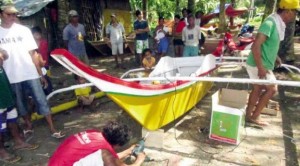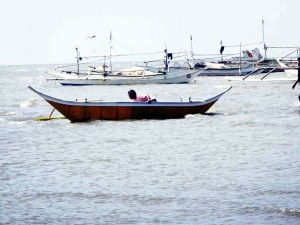‘Yolanda’ donors go for fiberglass boats

WORKERS construct fiberglass boats in the factory of Negrense Volunteers for Change at the reclamation area in Bacolod City. CARLA P. GOMEZ
When a volunteer group had raised enough funds to construct 1,600 boats for fishermen who lost their means of livelihood after Supertyphoon “Yolanda” swept northern Negros last November, a realization struck its leaders: To build wooden boats would mean cutting down an equal number of trees, which could cause devastating floods.
So Negrense Volunteers for Change (NVC) decided to shift from wood to fiberglass to prevent further destruction of the environment.
“Our vision is to provide the fishermen immediately with the tools of the trade,” Millie Kilayko, NVC president, said. “But the bigger vision is to provide their communities with technology transfer so that they ultimately become the manufacturing communities for fiberglass boats.”
Under the group’s Peter Project 2, fishermen-beneficiaries and their children will be given more chances of earning by teaching them how to build bancas made of fiberglass.
According to Garth Noel Tolentino, project manager, NVC has donations to build 1,600 boats—1,000 for wooden and 600 for fiberglass. One tree is needed to build one wooden boat; bigger trees can make two.
Article continues after this advertisement“With a donation lineup of 1,600 boats, we cannot bear to think that … we need to cut 1,600 trees. And to think that this number is only a fraction of the total need of the people in the devastated areas,” Kilayko said.
Article continues after this advertisementDonors’ interest
Social media postings on the fiberglass bancas raised a lot of interest among donors, who began asking how they could convert their donations to make the costlier vessels.
A 6-meter wooden banca with a 6.5-horsepower engine, inclusive of validation, monitoring and community organizing, costs P20,000. A fiberglass boat costs P5,000 more.
Apprehensive that the fishermen might not welcome a fiberglass boat, NVC brought them to typhoon-hit areas in Ormoc and Tacloban cities in Leyte province, Carles town in Iloilo province and Cadiz City in Negros Occidental province for a three-day exposure program to understand fiberglass.
NVC was happy with the results.

A FISHERMAN brings the fiberglass banca with only one outrigger to the deeper portion of the water to check if it will sink. CARLA P. GOMEZ
Advantages
“Not only did the fishermen get to understand fiberglass as a new medium, to remove their anxieties and fear of the unknown, more than that, they talked about bigger dreams— manufacturing and entrepreneurship,” Kilayko said.
Tolentino and naval architect Anthonieh Pasignajen taught the fishermen the advantages of using a fiberglass boat over a wooden banca—longer life span, lighter and less fuel consumption since these glide swiftly on the water.
Pasignajen, who makes yachts at Subic Bay Freeport, said he had waived his commission in the manufacture of fiberglass bancas for NVC. He works for BP Technologies, one of the NVC partners in the Yolanda Recovery Project.
He said he would like to see many young people become skilled in fiberglass production so that one day, when Europeans in the fiberglass industry would look for Filipino skilled laborers, they would find them in the Peter Project 2 fishing communities.
He dreamt of seeing factories rising in the communities, which could bring in more jobs.
Pasignajen said his group was working double time to produce the fiberglass boats so these would be turned over to the fishermen immediately. The faster they receive the boats, the sooner their lives return to normal.
Fishermen’s test
At the end of the exposure trip on Jan. 25, NVC brought the fishermen-beneficiaries to Hinigaran town in Negros Occidental to test the fiberglass bancas and their safety. They even tried to sink the boat, which they attached with an outrigger to only one side.
Fisherman Arnulfo Lacambra, 46, a resident of Tacloban, was excited to be owning a fiberglass boat, especially after discovering its durability.
“The assistance being given to us in Tacloban will eventually stop. Having a banca is important because it will enable me to make a living for myself instead of depending on others,” he said.
Lacambra and his wife lost all their belongings, including their house and banca, during the storm surge when Yolanda whipped Leyte.
Danilo Omotoc, 46, a resident of Ormoc, said the fiberglass boat would assure him of a source of livelihood for a long time. “We have been relying on relief stocks since Yolanda, but when the aid stops at least with a new boat we can survive,” said the father of eight children.
Benjie Tanes, 41, said his banca broke into three parts when Yolanda hit his municipality of Carles. Since he lost his source of livelihood, a daughter who is taking up hotel and restaurant management may have to drop out of college.
“With a fiberglass boat I will not only have means for my family to live, I will also be very happy that it will not be built from trees,” Tanes said.